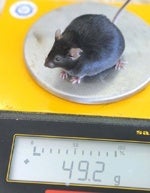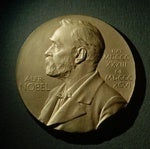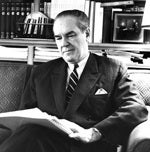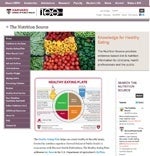A quick summary of some of the ways HSPH has changed our lives
Overcoming polio
 HSPH’s Thomas Weller shared the 1954 Nobel Prize in Physiology or Medicine with colleagues John Enders and Frederick Robbins of Harvard Medical School for their monumental 1949 discovery of a way to grow the polio virus in non-nerve-tissue cultures. Their work paved the way for the development of polio vaccines in the mid-1950s.
HSPH’s Thomas Weller shared the 1954 Nobel Prize in Physiology or Medicine with colleagues John Enders and Frederick Robbins of Harvard Medical School for their monumental 1949 discovery of a way to grow the polio virus in non-nerve-tissue cultures. Their work paved the way for the development of polio vaccines in the mid-1950s.
Prior to this, the mechanical respirator known as the “iron lung,” which was invented by HSPH faculty member Philip Drinker and colleague Louis Agassiz Shaw and first used on an 8-year-old girl in 1928, was responsible for preserving the lives of thousands of polio victims rendered unable to breathe without assistance.
Smallpox eradication
 HSPH alumnus William Foege developed the “surveillance and containment” vaccination method, which played a critical role in the eradication of smallpox, saving tens of millions of lives worldwide since the last naturally occurring case of the disease was reported in 1977.
HSPH alumnus William Foege developed the “surveillance and containment” vaccination method, which played a critical role in the eradication of smallpox, saving tens of millions of lives worldwide since the last naturally occurring case of the disease was reported in 1977.
Healthier eating
HSPH has provided millions with simple guidelines on healthier eating and the scientific support behind those guidelines for more than 70 years. Established in 1942, the School’s Department of Nutrition is the oldest of its kind within an American medical or public health school.
Millions spared from cholera death
 Oral rehydration therapy, a low-cost, low-tech solution developed by HSPH’s [[Richard Cash]] and colleague David Nalin, is credited with sparing tens of millions who would otherwise have died from dehydration due to cholera and other diarrheal diseases.
Oral rehydration therapy, a low-cost, low-tech solution developed by HSPH’s [[Richard Cash]] and colleague David Nalin, is credited with sparing tens of millions who would otherwise have died from dehydration due to cholera and other diarrheal diseases.
Cleaner air and pollution policy
 HSPH’s Six Cities Study demonstrated the dangers of small-particle pollution caused by fossil fuel combustion, as well as the risks of indoor pollution to human health. The landmark study provided key evidence for revisions to the U.S. Clean Air Act, which is credited with saving millions of lives and preventing tens of millions of cases of pollution-related illness.
HSPH’s Six Cities Study demonstrated the dangers of small-particle pollution caused by fossil fuel combustion, as well as the risks of indoor pollution to human health. The landmark study provided key evidence for revisions to the U.S. Clean Air Act, which is credited with saving millions of lives and preventing tens of millions of cases of pollution-related illness.
Saving premature infants
 An HSPH postdoctoral student by the name of Mary Ellen Avery helped prevent the deaths of more than 14,000 premature infants each year by discovering that the absence of a certain mix of fat and proteins in their lungs is the most common precursor of death in these babies.
An HSPH postdoctoral student by the name of Mary Ellen Avery helped prevent the deaths of more than 14,000 premature infants each year by discovering that the absence of a certain mix of fat and proteins in their lungs is the most common precursor of death in these babies.
Taking on Lyme disease
 HSPH’s Andrew Spielman in 1976 discovered the deer tick that transmits Nantucket fever, which was later shown to transmit Lyme disease as well. Spielman also recommended the now widely used strategy of culling deer populations to reduce Lyme disease.
HSPH’s Andrew Spielman in 1976 discovered the deer tick that transmits Nantucket fever, which was later shown to transmit Lyme disease as well. Spielman also recommended the now widely used strategy of culling deer populations to reduce Lyme disease.
Fighting Fat
 HSPH researchers were instrumental in proving and publicizing the dangers of trans fats, leading to bans, new food labeling standards, and the removal of these heart-harming fats from many restaurants and packaged foods. HSPH researchers also helped show that not all fat is “bad fat,” revolutionizing nutritional advice from the U.S. government and health experts worldwide.
HSPH researchers were instrumental in proving and publicizing the dangers of trans fats, leading to bans, new food labeling standards, and the removal of these heart-harming fats from many restaurants and packaged foods. HSPH researchers also helped show that not all fat is “bad fat,” revolutionizing nutritional advice from the U.S. government and health experts worldwide.
An aspirin a day
HSPH’s Charles Hennekens and colleagues demonstrated the protective effects of taking one aspirin daily, inspiring doctors to recommend this simple means of reducing the risk of heart attack, stroke, and other health problems to millions of people.
Designated driver campaign
 HSPH made the phrase “Designated Driver” part of popular culture in the U.S., changing social norms and public policies around drunken driving. A campaign initiated by Jay Winsten, Frank Stanton Director of the School’s Center for Health Communication, in 1988 partnered with an array of Madison Avenue marketing firms, TV networks, and Hollywood media to curb alcohol-related traffic accidents by promoting the phrase. The concept of a “designated driver” was incorporated into the scripts of more than 160 episodes of popular shows. Six years into the campaign, new laws and stricter enforcement—and the designated driver campaign—had contributed to a 30 percent drop in alcohol-related fatalities.
HSPH made the phrase “Designated Driver” part of popular culture in the U.S., changing social norms and public policies around drunken driving. A campaign initiated by Jay Winsten, Frank Stanton Director of the School’s Center for Health Communication, in 1988 partnered with an array of Madison Avenue marketing firms, TV networks, and Hollywood media to curb alcohol-related traffic accidents by promoting the phrase. The concept of a “designated driver” was incorporated into the scripts of more than 160 episodes of popular shows. Six years into the campaign, new laws and stricter enforcement—and the designated driver campaign—had contributed to a 30 percent drop in alcohol-related fatalities.
Focus on cancer prevention
A pivotal HSPH report in 1996 compelled a greater emphasis on lifestyle changes in cancer prevention strategies by showing that more than half of U.S. cancer deaths result from behavior choices, including smoking, poor diet, obesity, and lack of exercise.
Obese mice and disease prevention
 HSPH’s Gökhan Hotamisligil and colleagues developed genetically engineered obese mice resistant to many of the ill effects of excess weight, improving our understanding of what happens when the body’s metabolic machinery is overwhelmed by excess nutrients and fats.
HSPH’s Gökhan Hotamisligil and colleagues developed genetically engineered obese mice resistant to many of the ill effects of excess weight, improving our understanding of what happens when the body’s metabolic machinery is overwhelmed by excess nutrients and fats.
Genetic detective work
HSPH formulated statistical methods that led to the identification of genetic variants that increase susceptibility to a wide variety of diseases, including breast cancer. The School also made fundamental discoveries that help explain the underlying causes of diseases connected to obesity, including type 2 diabetes and heart disease.
Making surgery safer
 Surgical errors and complications were reduced by more than one-third in many operating rooms around the U.S. and worldwide, thanks to a surgical checklist initiative begun in 2008 and led by HSPH’s [[Atul Gawande]] and colleagues working with WHO.
Surgical errors and complications were reduced by more than one-third in many operating rooms around the U.S. and worldwide, thanks to a surgical checklist initiative begun in 2008 and led by HSPH’s [[Atul Gawande]] and colleagues working with WHO.
Right to die, patients’ rights
The School developed criteria that shaped guidelines for the nation’s first legislation on brain death, helping inform the “right to die” debate.
Patient Safety Movement
HSPH launched the “patient safety movement” with the publication of the landmark Harvard Medical Practice Study in the early 1990s, which established the standard by which adverse events are measured and showed that a substantial number of patient injuries in hospitals are caused by preventable medical errors and substandard care. The Institute of Medicine’s 1999 report, To Err Is Human, put the number of hospital deaths caused by medical errors at an estimated 44,000–98,000 annually.
Bias in medical care
The School exposed potential biases in how medical professionals treat poor and minority patients by providing evidence of disparities in rates of surgery and quality of care.
Cost effectiveness in medical care
HSPH forged the discipline now known as health decision science with pioneering studies of the cost effectiveness of medical interventions.
Health makes wealth
The concept of the “demographic dividend” pioneered by HSPH faculty member [[David Bloom]] and colleagues was featured in Time magazine’s “Ten Ideas That Will Change the World,” published in March 2011. The concept describes changes that could occur in developing countries as health improvements and falling infant mortality lead to a baby boom generation and eventually lower birth rates, fueling rapid economic growth.
Battling binge drinking
 The Harvard College Alcohol Study, led by HSPH’s Henry Wechsler, documented that binge drinking can be curtailed by a combination of actions, including changing the culture around drinking, instituting and enforcing strong drunken driving laws, passing laws preventing high-volume sales (drinks served in pitchers or buckets, putting restrictions on keg sales), and limiting irresponsible marketing practices such as 25-cent beers, ladies’ nights, and all-you-can-drink specials. The study also documented the extent of binge drinking among college students and its effects not only on the drinkers but on other students and nearby neighborhoods.
The Harvard College Alcohol Study, led by HSPH’s Henry Wechsler, documented that binge drinking can be curtailed by a combination of actions, including changing the culture around drinking, instituting and enforcing strong drunken driving laws, passing laws preventing high-volume sales (drinks served in pitchers or buckets, putting restrictions on keg sales), and limiting irresponsible marketing practices such as 25-cent beers, ladies’ nights, and all-you-can-drink specials. The study also documented the extent of binge drinking among college students and its effects not only on the drinkers but on other students and nearby neighborhoods.
Inventing veterinary public health
 James H. Steele, MPH ’42, helped lay the groundwork for much of our understanding of how diseases jump from animals to people and spearheaded pioneering work leading to development of a safe, effective rabies vaccine. Steele, who was born in 1913, the same year that the Harvard-MIT School for Health Officers was founded, is among the School’s oldest living alumni.
James H. Steele, MPH ’42, helped lay the groundwork for much of our understanding of how diseases jump from animals to people and spearheaded pioneering work leading to development of a safe, effective rabies vaccine. Steele, who was born in 1913, the same year that the Harvard-MIT School for Health Officers was founded, is among the School’s oldest living alumni.
Eradicating Guinea worm disease
HSPH alumnus Donald Hopkins, MPH ’70, has played a leading role in the Guinea worm disease eradication effort since 1986. At that time, there were 3.5 million cases of the disease worldwide; in 2012, there were fewer than 600.
Tackling tobacco
 More than 30 years ago, HSPH’s Dimitrios Trichopoulos published a paper that provided definitive evidence of a link between “secondhand smoke” and lung cancer in nonsmokers.
More than 30 years ago, HSPH’s Dimitrios Trichopoulos published a paper that provided definitive evidence of a link between “secondhand smoke” and lung cancer in nonsmokers.
Still on the front lines of the fight to control tobacco today, HSPH has worked with officials across the U.S. and around the world, including leaders from Armenia, China, El Salvador, Greece, Ireland, Israel, Philippines, Poland, and Taiwan to advance tobacco control strategies such as bans on smoking in public places.
Leaders, leaders, leaders
HSPH graduates have led dozens of local, state, national, and international health agencies, and even national governments. Two HSPH alumni have been heads of state. Five of the last 10 directors of the U.S. Centers for Disease Control and Prevention are HSPH alumni. One HSPH alumna headed the World Health Organization.
Award winners
 Faculty members have received the Nobel Prize or headed an organization that received the Nobel. Many more faculty and alumni have received major academic and research awards and honors, including the MacArthur Foundation “genius grants,” the Presidential Medal of Freedom, and many others.
Faculty members have received the Nobel Prize or headed an organization that received the Nobel. Many more faculty and alumni have received major academic and research awards and honors, including the MacArthur Foundation “genius grants,” the Presidential Medal of Freedom, and many others.
Documenting the global burden of disease
 HSPH faculty collaborated with more than 300 other institutions in 50 countries on the ambitious 2010 Global Burden of Disease Study, which provided key insights into the changing causes of disease and death around the globe.
HSPH faculty collaborated with more than 300 other institutions in 50 countries on the ambitious 2010 Global Burden of Disease Study, which provided key insights into the changing causes of disease and death around the globe.
Revolutionizing clinical trials research
Through the efforts of HSPH’s [[Marvin Zelen]], Stephen Lagakos, and others, HSPH helped transform clinical trial research into a well-managed, statistically sophisticated branch of medical inquiry, setting the standard for data management in areas such as drug trials, cancer studies, and AIDS clinical trials.
Curbing cervical cancer
 HSPH’s [[Sue Goldie]] used predictive modeling to find the most cost-effective strategies to screen for and vaccinate against human papillomavirus, the virus linked to cervical cancer. Work by Goldie and colleagues has informed position statements on this issue by the World Health Organization, influenced investment choices by foundations and public-private alliances, and helped frame government policies in poor and middle-income regions, where the disease kills more than 200,000 women each year.
HSPH’s [[Sue Goldie]] used predictive modeling to find the most cost-effective strategies to screen for and vaccinate against human papillomavirus, the virus linked to cervical cancer. Work by Goldie and colleagues has informed position statements on this issue by the World Health Organization, influenced investment choices by foundations and public-private alliances, and helped frame government policies in poor and middle-income regions, where the disease kills more than 200,000 women each year.
Health impact of heavy metals
 HSPH environmental health experts demonstrated the dangers posed to human health by heavy metals such as lead, arsenic, and manganese.
HSPH environmental health experts demonstrated the dangers posed to human health by heavy metals such as lead, arsenic, and manganese.
Oxygen and gas
HSPH faculty developed protective oxygen masks used by U.S. pilots in WWII and invented protective gas masks for the Army’s Chemical Warfare Service.
“Thank God for Marvin Zelen!”
HSPH’s [[Marvin Zelen]] and colleagues investigated a cluster of childhood leukemia cases in Woburn, Massachusetts, in the early 1980s, implicating the town’s contaminated water supply in a variety of adverse health effects. The high-profile case, which spurred Congress to expand Superfund legislation and funding, was later dramatized in the book and movie A Civil Action.
Creating the first state-level single-payer health system
 A team led by HSPH’s [[William Hsiao]] crafted the plan for Vermont’s single payer health insurance system—the first of its kind in the U.S.—which was signed into law in 2011. According to the New England Journal of Medicine, administrators expect the program to provide both expanded health care services and net savings of $35 million in 2017, the program’s first year of operation.
A team led by HSPH’s [[William Hsiao]] crafted the plan for Vermont’s single payer health insurance system—the first of its kind in the U.S.—which was signed into law in 2011. According to the New England Journal of Medicine, administrators expect the program to provide both expanded health care services and net savings of $35 million in 2017, the program’s first year of operation.
Physician payment system
[[William Hsiao]] and colleagues also developed the resource-based relative value scale method, which is used to calculate compensation rates for medical procedures in most public and private insurance programs in the U.S. and many other countries.
Pioneering aerospace medicine
 In a career spanning more than 30 years—from the mid-1930s and the earliest days of commercial aviation to the early 1970s—Ross McFarland, who joined HSPH in 1947, contributed to the birth of aerospace medicine. McFarland studied how oxygen deprivation can cloud judgment, evaluated the size and illumination of instrument panels on planes to see if they were legible at extreme speeds, and worked with Pan American Airlines to study pilot fatigue on long flights. He corresponded with Amelia Earhart prior to her doomed flight around the world and was friends with Charles Lindbergh and many other pilots. The warning you hear on every commercial airline flight—“In the unlikely event of a drop in cabin pressure . . . ”—is the result of studies conducted by Ross McFarland.
In a career spanning more than 30 years—from the mid-1930s and the earliest days of commercial aviation to the early 1970s—Ross McFarland, who joined HSPH in 1947, contributed to the birth of aerospace medicine. McFarland studied how oxygen deprivation can cloud judgment, evaluated the size and illumination of instrument panels on planes to see if they were legible at extreme speeds, and worked with Pan American Airlines to study pilot fatigue on long flights. He corresponded with Amelia Earhart prior to her doomed flight around the world and was friends with Charles Lindbergh and many other pilots. The warning you hear on every commercial airline flight—“In the unlikely event of a drop in cabin pressure . . . ”—is the result of studies conducted by Ross McFarland.
The Nutrition Source
 Do a Google search on the terms“carbohydrate,” “sugary drinks,” “fats and cholesterol,” or “fruits and vegetables,” and one of the top results invariably will be The Nutrition Source. Launched by Harvard School of Public Health’s Department of Nutrition in 2001—when low-fat diets were popular, the harmful effects of trans fats were becoming apparent, and even the U.S. Department of Agriculture was issuing dietary advice that was not scientifically valid—the website provides evidence-based information for consumers, health professionals, and reporters.
Do a Google search on the terms“carbohydrate,” “sugary drinks,” “fats and cholesterol,” or “fruits and vegetables,” and one of the top results invariably will be The Nutrition Source. Launched by Harvard School of Public Health’s Department of Nutrition in 2001—when low-fat diets were popular, the harmful effects of trans fats were becoming apparent, and even the U.S. Department of Agriculture was issuing dietary advice that was not scientifically valid—the website provides evidence-based information for consumers, health professionals, and reporters.
Accepting no advertising or commercial sponsorship, The Nutrition Source offers objective, unbiased information on one of today’s most contentiously debated public health questions. Each month, it draws some 500,000 unique visitors. In the dozen years since it was established, the site has hosted visitors from every country in the world.
“Nutrition information in the media is loaded with sensationalized claims touting the benefits of this food or that. This is especially true with diet books authored by celebrities who don’t have science-based expertise,” explained the site’s editorial director, [[Lilian Cheung]], lecturer on nutrition and director of Health Promotion and Communication in the Department of Nutrition. “Scientific studies can also be confusing and contradictory when journalists report on single-study findings without putting new evidence into the larger perspective of existing research on the subject.”
At The Nutrition Source HSPH faculty and other invited experts review all content before it is posted. Information is re-reviewed regularly, to ensure that it is timely and scientifically up to date. “We want to tell the truth,” said Cheung, “supported by good science.”
Download a PDF of A century of powerful ideas